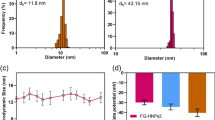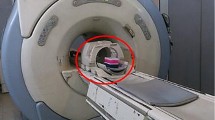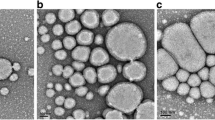Abstract
Nanosized materials of gadolinium oxide can provide high-contrast enhancement in magnetic resonance imaging (MRI). The aim of this research was to characterize a novel emulsion composed of a silicon-based nanocomposite polymer (NCP) and gadolinium (III) oxide (Gd2O3) nanoparticles. The size and morphological structure of this nanoparticle are determined by particle size analysis device (zeta sizer) and transmission electronic microscope. We determined composition of Gd2O3 nanoparticles with energy dispersive X-ray analysis (EDXA) and magnetic resonance signal by T 1-weighted MRI. Cytotoxicity of Gd2O3 nanoparticles in SK-MEL-3 cancer cells was evaluated. Zeta sizer showed Gd2O3 nanoparticles to be 75 nm in size. EDXA indicated the two main chemical components of gadolinium-nanocomposite polymer emulsion: gadolinium and silicon and MRI also showed a significantly higher incremental relaxivity for Gd2O3 nanoparticles compared to Magnevist (conventional contrast agent). In such concentrations, the slope of R1 relaxivity (1/T 1) vs. concentration curve of Magnevist and Gd2O3 were 4.33, 7.98 s−1 mM−1. The slope of R2 relaxivity (1/T 2) vs. concentration curve of Magnevist and Gd2O3 were 5.06, 13.75 s−1 mM−1. No appreciable toxicity was observed with Gd2O3 nanoparticles. Gadolinium-nanocomposite polymer emulsion is well characterized and has potential as a useful contrast agent for magnetic resonance molecular imaging.






Similar content being viewed by others
References
Weissleder R, Mahmood U (2001) Molecular imaging. Radiology 219:316–333
Lin S, Brown J (2007) MR contrast agents: physical and pharmacologic basics. Magn Reson Imaging 25:884–899
Aime S, Botta M, Fasano M, Terreno E (1998) Lanthanide(III) chelates for NMR biomedical applications. J Chem Soc Rev 27:19–29
Jianghua F, Guoying S, Fengkui P et al (2003) Comparison between Gd-DTPA and several bisamide derivatives as potential mri contrast agents. Bioorg Med Chem 11:3359–3366
Hengerer A, Grimm J (2006) Molecular magnetic resonance imaging. Biomedical Imaging and Intervention 2:63–68
Jagannathan N (2007) Molecular imaging in biomedical research. Curr Sci 92:1061–1070
Paschkunova-Martic I, Kremser C, Mistlberger K et al (2005) Design, synthesis, physical and chemical characterisation, and biological interactions of lectin-targeted latex nanoparticles bearing Gd-DTPA chelates: an exploration of magnetic resonance molecular imaging (MRMI). Histochem Cell Biol 123:283–301
Morawski AM, Winter PM, Crowder KC et al (2004) Targeted nanoparticles for quantitative imaging of sparse molecular epitopes with MRI. Magn Reson Med 51:480–486
Vuu K, Xie J, McDonald MA et al (2005) Gadolinium-rhodamine nanoparticles for cell labeling and tracking via magnetic resonance and optical imaging. Bioconjug Chem 16:995–999
Mulder WJ, Koole R, Brandwijk RJ et al (2006) Quantum dots with a paramagnetic coating as a bimodal molecular imaging probe. Nano Lett 6:1–6
Kannan RY, Butler PE, Seifalian AM et al (2006) The endothelialization of polyhedral oligomeric silsesquioxane nanocomposites: an in vitro study. Cell Biochem Biophys 45:129–136
Kao W (1999) Evaluation of protein-modulated macrophage behaviour on biomaterials: designing biomimetic materials for cellular engineering. J Biomaterials 20:2213–2221
Schubert MA, Wiggins MJ, Anderson JM et al (1997) Role of oxygen in biodegradation of poly (etherurethane urea) elastomers. J Biomed Mater Res 34:519–530
Berrocal M, Badr I, Gao D et al (2001) Reducing the thrombogenicity of ion-selective electrode membranes through the use of a silicone-modified segmented polyurethane. J Anal Chem 73:5328–5333
Ng CE, Bussey AM, Raaphorst GP (1994) Inhibition of potentially lethal and sublethal damage repair by camptothecin and etoposide in human melanoma cell lines. Int J Radiat Biol 66:49–57
Smit N, Peters K, Menko W et al (1992) Cytotoxicity of a selected series of substituted phenols towards cultured melanoma cells. Melanoma Res 2:295–304
Mulder WJ, Strijkers GJ, van Tilborg GA et al (2006) Lipid-based nanoparticles for contrast-enhanced MRI and molecular imaging. NMR Biomed 19:142–164
Kobayashi H, Kawamoto S, Brechbiel MW et al (2005) Detection of lymph node involvement in hematologic malignancies using micromagnetic resonance lymphangiography with a gadolinium-labeled dendrimer nanoparticle. Neoplasia 7:984–991
Sipkins DA, Cheresh DA, Kazemi MR et al (1998) Detection of tumor angiogenesis in vivo by alphaVbeta3-targeted magnetic resonance imaging. Nat Med 4:623–626
Bulte JW, Hoekstra Y, Kamman RL et al (1992) Specific MR imaging of human lymphocytes by monoclonal antibody-guided dextran-magnetite particles. Magn Reson Med 25:148–157
Flacke S, Fischer S, Scott MJ et al (2001) Novel MRI contrast agent for molecular imaging of fibrin: implications for detecting vulnerable plaques. Circulation 104:1280–1285
Acknowledgments
This work was supported in part by the research chancellor of Tehran University of Medical Sciences (TUMS)-Tehran-Iran.
Author information
Authors and Affiliations
Corresponding author
Rights and permissions
About this article
Cite this article
Riyahi-Alam, N., Behrouzkia, Z., Seifalian, A. et al. Properties Evaluation of a New MRI Contrast Agent Based on Gd-Loaded Nanoparticles. Biol Trace Elem Res 137, 324–334 (2010). https://doi.org/10.1007/s12011-009-8587-3
Received:
Accepted:
Published:
Issue Date:
DOI: https://doi.org/10.1007/s12011-009-8587-3




